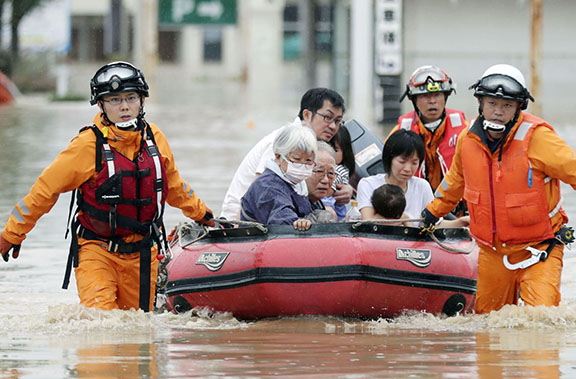 When deadly floods and mudslides devastated communities across southwestern Japan in 2018, many survivors were afflicted with post-traumatic stress disorder (PTSD). They had lived through complete devastation and the loss of home, family, friends, and all sense of security. At this time, the city government in Hiroshima reached out to Sumati Chiemi Hori, an Integral Yoga teacher, and Integral Yoga Stress Management Teacher. In this article, Sumati reflects on her experience instructing Yoga to survivors of the devastation. Read on as she highlights the Yogic stress management techniques she found most effective for students struggling with PTSD.
When deadly floods and mudslides devastated communities across southwestern Japan in 2018, many survivors were afflicted with post-traumatic stress disorder (PTSD). They had lived through complete devastation and the loss of home, family, friends, and all sense of security. At this time, the city government in Hiroshima reached out to Sumati Chiemi Hori, an Integral Yoga teacher, and Integral Yoga Stress Management Teacher. In this article, Sumati reflects on her experience instructing Yoga to survivors of the devastation. Read on as she highlights the Yogic stress management techniques she found most effective for students struggling with PTSD.
I had taken the 200-hour Integral Yoga Teacher Training but my ability to serve all students was still limited. I took the Integral Yoga Stress Management Teacher Training (SMTT) hoping to learn how to teach chair Yoga and adapt poses for my disabled and senior students. In that training, I learned about adapted poses as well as Yoga-based stress management. It changed my approach to teaching in ways I could have never imagined.
After completing the SMTT, one can teach the full benefits of Yoga in an office, classroom, senior home, or daycare center. The training specifically adapts the teachings of Yoga to many different populations and environments. As a result, I’ve been able to teach children, sick people, grocery store employees, and survivors of cancer and trauma.
After graduating, I started teaching three small classes for seniors as a community service in Mihara, Hiroshima. Additionally, I taught a regular gentle Yoga class using ideas from SMTT. One of my students, a nurse, asked me to give a stress reduction class for doctors and nurses at Kousei hospital in Daiwa. They enjoyed the class, and the hospital later invited me to speak to their employees. After that, another of my students invited me to teach parents of young children at a local Christian school because the students were so stressed. Later, I gave a stress management class for caretakers of senior or disabled persons. It was a joy to serve those who give so much of themselves in caring for others.
All of these experiences prepared me for my next teaching challenge; helping those suffering from PTSD with Yoga for stress management.
The Integral Yoga approach works on every level: physical, emotional, and mental. As the stress response originates in the mind, we use the disciplines of Yoga to release stressful thoughts from the mind as well as the physical stretches to release the tension stored in the body. For trauma survivors, it is vital to emphasize being in the present moment.
In 2018, when I was asked by my city government to give stress management classes for survivors experiencing PTSD from the devastating floods, I adapted the practices to help my students focus on the present moment. We acknowledged that, yes, a terrible thing has happened, but we are here now. I encouraged them to find purpose by serving others, to give a sense of empowerment rather than victimhood, and I would bring them into the present moment again and again.
Clearly, my students needed a great deal of emotional release and encouragement. In SMTT we learned tools to facilitate group discussion. Before starting the formal class practices, I encouraged my students to talk and discuss whatever they felt. I would choose pertinent topics and share positive stories, adapting each class to what my students needed.
In order to release emotions and create a sense of empowerment, I taught lots of lion pose and uddiyana bandha (abdominal lift). We did heart-opening poses to release trauma from the chest and heart. Some poses were in a chair, while others were on a mat.
If I was teaching in a big space, I would often do twenty minutes of adapted Yoga relaxation. Many of my students had trouble sleeping at night. We practicing entering the present moment, deep breathing, and incorporated the option of using imagery. We practiced deep breathing often together as it is the most portable form of stress release.
At the beginning of classes, the students were so anxious their shoulders were tensed up around their ears. However, by the end of class, their shoulders had relaxed down. As the months went on, smiles and laughter returned to their faces and after five months you could see a tangible physical difference.
I offered these classes as Karma Yoga, a free offering for the joy of service and I was paid with so much love in return. Through these experiences, I learned that really all of Integral Yoga is stress management. We can learn how to release the heaviness that we create for ourselves through the beautiful tools of Yoga and share with students a different perspective to see things in a new light.
 About the Author:
About the Author:
Sumati Chiemi Hori is an Integral Yoga teacher and Integral Yoga Stress Management Teacher who lives in Japan.

